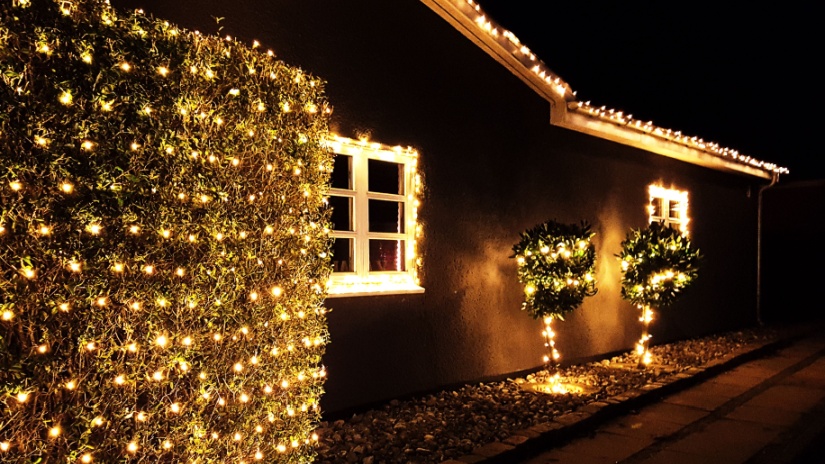Knowledge Centre
What are your Christmas lights costing you?

The holiday season is a special time for gathering with loved ones, and Christmas lights are a delightful way to brighten up the festivities. However, as the holiday cheer fades and the reality of post-Christmas bills sets in, many people start worrying about the impact of those twinkling lights on their energy costs.
There’s a common concern that Christmas lights significantly inflate your electricity bill, but that’s not entirely accurate today. Curious about how much those festive lights are really adding to your energy expenses?
We’ve crunched the numbers and examined other factors that might be contributing to your higher bills during the holiday season.
What do your Christmas lights cost to run?
If you’ve upgraded to solar-powered Christmas lights, you won’t see any additional charges on your electricity bill. For those still using traditional lights, switching to LED options can help you save on energy costs during the festive season.
LED Christmas lights are remarkably efficient, typically adding just $1 to $2 to your electricity bill for the whole month. In contrast, older incandescent bulbs - banned in Australia since 2009 due to their high energy consumption - could have cost around $10 for the same period. If you’ve had your lights for over a decade, you might still be using incandescent bulbs, but most people should now have energy-efficient LED or solar-powered lights.
To help you understand the cost of running various Christmas lights, we’ve calculated the energy expenses for some common types of lights you might find at department stores.
LED string size (no. of lights) | Wattage | Hourly running cost | Cost during December (6 hours a day) | Cost during December (24 hours a day) |
| 100 lights | 6W | 1.62c | $2.92 | $11.68 |
| 200 lights | 12W | 3.24c | $5.83 | $23.35 |
| 300 lights | 18W | 4.86c | $8.74 | $35.02 |
| 500 lights | 30W | 8.10c | $14.57 | $58.29 |
The table shows the estimated costs based on an average electricity rate of 27c/kWh, with the assumption that the lights are used throughout December.
These figures serve as a general reference. The actual costs may differ based on several factors, including:
- The size and luminosity of your Christmas lights
- Whether your lights are static or flashing
- The electricity rates in your area
Given the minimal overall expense, these variations are unlikely to significantly affect your final bill.
How much power do light bulbs really use?
You might be surprised to learn that modern light bulbs are quite energy efficient. Here’s a comparison of their power usage versus other common household appliances:
| Appliance | Energy usage (kWh) | Cost |
| LED bulb | 8.8 kWh (6 hours a day) | $2.37 |
| Incandescent bulb | 55 kWh (6 hours a day) | $14.85 |
| Refrigerator | 330 kWh | $89.10 |
| Television | 338 kWh | $91.26 |
| Air conditioner | 396 kWh | $106.92 |
As you can see, even if you use a lot of LED bulbs, their impact on your electricity bill is relatively minor compared to these other appliances.
What about big Christmas displays?
While Christmas lights themselves are quite affordable to run, you might wonder about those large inflatable decorations you set up in your yard.
Generally, these inflatables use similar types of bulbs as your standard Christmas lights, so they don’t consume much more power.
However, some exceptions do exist. For example, a 2.5-meter-tall inflatable Santa in a snowmobile typically uses around 24 watts for its lighting. Even if you keep it lit 24 hours a day, it will cost you roughly $4.82 for the whole month. This is a small amount compared to the initial cost of the decoration.
How to lower your energy bill during the Christmas season
Switch energy plans
With extra appliances running and your home decked out in festive lights, it’s crucial to avoid high energy rates. Take some time to compare your current energy plan with others available in the market.
Finding a better deal can help you manage your bills and avoid surprises at the end of the holiday season, but our team are available on 1300 790 106 to help.
Set a reasonable aircon temperature
Adjusting your air conditioner’s temperature can significantly impact your energy usage. Each additional degree of cooling can increase your energy consumption by about 10%. For instance, setting your aircon to 22°C instead of 20°C can reduce your energy use by 20%, potentially saving you $50 annually.
Use strategic shading
To reduce air conditioner usage, consider using curtains to block out the heat during the day or keeping windows open to allow cool air in. This simple adjustment can help your home stay cooler without overworking your aircon.
Improve insulation
Proper insulation helps keep your home comfortable and reduces the need for extra heating or cooling. Seal gaps in doors, windows, and around skirting boards with fillers or draught excluders to minimise the amount of hot air entering your house.
Upgrade your lighting
If you’re still using incandescent or halogen bulbs, switching to energy-efficient LED bulbs can lead to significant savings. Each LED bulb can save you $10 or more per year compared to traditional bulbs.
Consider solar Christmas lights
Solar-powered Christmas lights are a great way to reduce your energy costs as they use sunlight to operate. However, they only work when there’s sufficient sunlight, so they might not stay lit throughout the night. They can be more expensive to purchase initially, but they save on electricity costs.
Avoid overstocking
It’s tempting to fill your fridge with holiday treats but overloading it can obstruct air vents and increase cooling costs. Plan your food purchases carefully to avoid unnecessary energy use.
Use a timer for lights
To prevent your Christmas lights from staying on all night, use a switch timer. This will help ensure your lights are only on for a few hours and can also prevent complaints from neighbours.
Plan your light display wisely
Flashing or twinkling lights consume more electricity than steady ones. To save energy, opt for solid lights and turn them on only when it’s completely dark (around 7pm, depending on your location). Limit your display to December and avoid excessive lighting to keep energy use in check.
Switching energy providers: A key strategy for lowering your bills
One of the most effective ways to reduce your energy costs is by switching to a more affordable energy plan. No matter how much electricity you use, a better plan can lead to significant savings on your monthly bills.
To start saving, consider comparing energy plans to find the best deal for your needs. You can easily begin this process by contacting Compare Energy at 1300 790 106. Their team can help you evaluate your current plan against available options and facilitate a switch to a more cost-effective provider. With their assistance, you could be switched to a new provider within just 2 business days of applying.
By taking this simple step, you can potentially lower your energy expenses and ensure you're getting the best value for your money.

